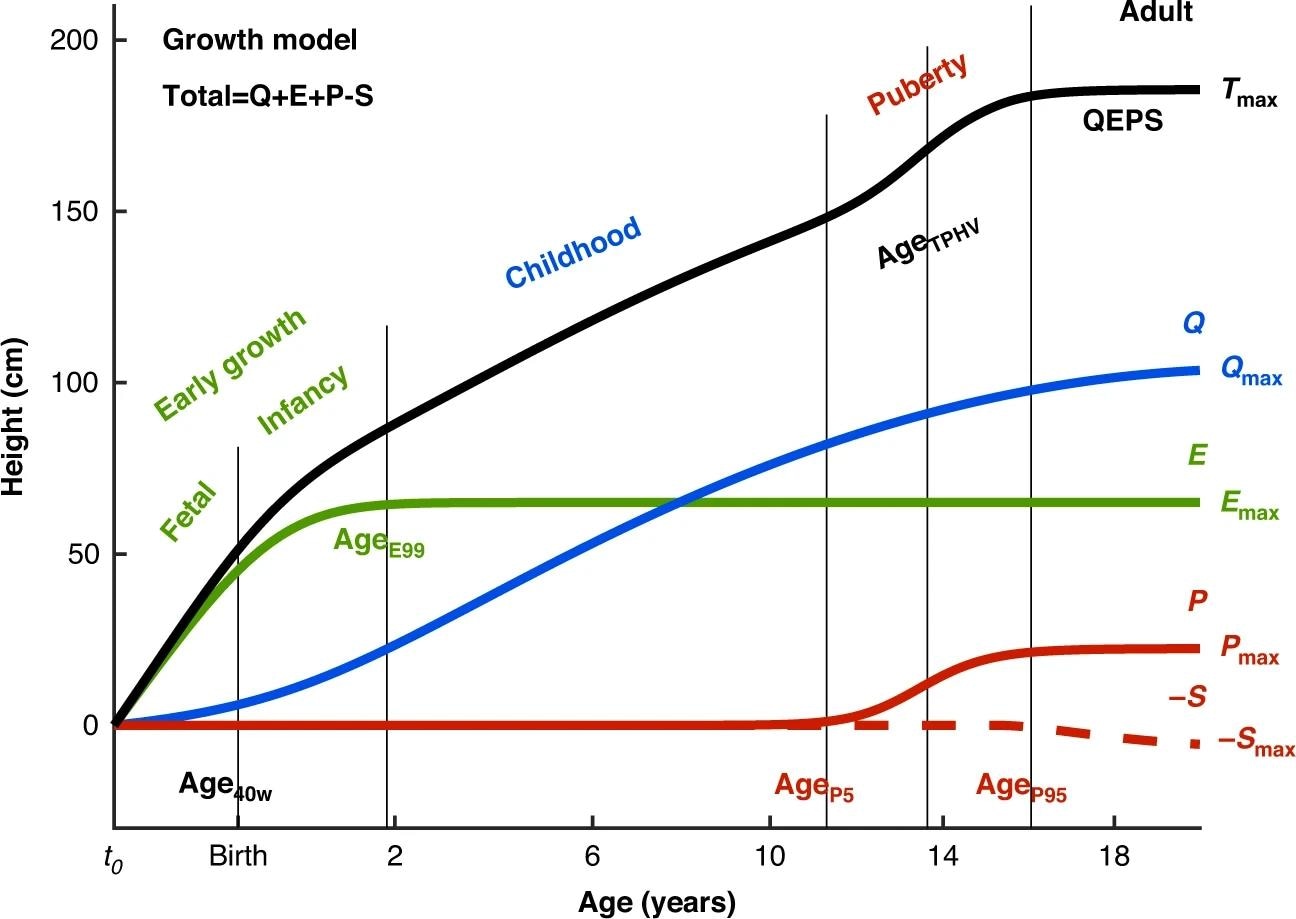New research reveals that early growth patterns can help predict adult height and pubertal growth, but not when puberty will begin—challenging assumptions about how early development shapes lifelong outcomes.
 Population Study: Early life growth is related to pubertal growth and adult height – a QEPS-model analysis. Image Credit: Anton Vierietin / Shutterstock
Population Study: Early life growth is related to pubertal growth and adult height – a QEPS-model analysis. Image Credit: Anton Vierietin / Shutterstock
In a recent study in the journal Pediatric Research, researchers used the relatively novel Quadratic-Exponential-Pubertal-Stop (QEPS) model to elucidate the relationship between early life growth metrics and later life outcomes.
Specifically, they investigated the associations between early life length changes, pubertal growth amplitude and timing, and adult height. They used an extensive retrospective Swedish cohort (GrowUp Gothenburg; n = 4700) assessed via linear regression models (uni- and multivariate).
Study findings reveal that early life growth is strongly associated with pubertal growth amplitude and adult height but does not significantly influence the timing of puberty.
These results suggest that early life growth can serve as a predictive marker for an individual's future growth trajectory, but its role in broader health outcomes remains unclear. Future research should aim to unravel the specific biological mechanisms underlying these associations, as they remain only partly understood.
Background
Previous studies have established a link between early life (conception till ~2 years) and adult growth, health, and development. This 'fetal-infancy' stage has been proven to be a critical marker of adult morbidity and mortality, highlighting its importance and spurring early life growth research.
More recent research has shown that nutritional status and stress are both key regulators of early life growth. Notably, postnatal overnutrition has been found to have little impact on adult height outcomes, but early malnutrition has been shown to leave a lasting and irreversible impact on final adult height.
Similarly, chronic early life stress is believed to both impair future growth and force the earlier onset of puberty, potentially via the premature activation of neuroendocrine pathways. However, this study did not directly investigate the role of stress in pubertal timing but acknowledged it as a potential contributing factor.
To better understand the relationship between early life stages and later life outcomes, two 'growth models' have been proposed – the Infancy-Childhood-Puberty (ICP) model and the more recent Quadratic-Exponential-Pubertal-Stop (QEPS) model. The latter model outperforms the former by allowing the delinking of otherwise continuous growth phases – early life (E), puberty (P), and ongoing (Q) growth.
About the Study
The present study aimed to leverage the QEPS growth model with longitudinal height/length data to elucidate the impacts of early life growth on pubertal growth, puberty onset timing, and adult height outcomes.
"We hypothesized that early life growth is related to both the timing and amplitude of pubertal growth, as well as the attained adult height."
Study data was obtained from the Combo GrowUp Gothenburg cohort, a Swedish cohort of participants from 1974 and 1990 for whom all birth sizes, gestational ages, and longitudinal measurements were recorded across all age periods (infancy through adult).
Participants suffering from chronic diseases and those for whom accurate parent height measurements were unavailable were excluded from the analyses.
For QEPS input, univariate and multivariate linear regression models of participants' longitudinal height at various periods (early life, childhood, and puberty) were used to create individual-specific longitudinal length/height curves tracing growth from birth to adulthood. These models were computed separately for males and females.
"The QEPS growth model was used to describe individual length/height growth from birth to adult height, defining an individual's growth as a combination of four distinct mathematical functions; a Quadratic (Q) function, for the basic ongoing growth starting from early fetal life until the end of growth, stopped by a Stop (S) function, a negative Exponential (E) function, specific for growth during fetal life and infancy, and a non-linear Pubertal (P) function specific for pubertal growth."
The primary outcome of interest in the analyses was pubertal growth (height gained by and during puberty), with age at puberty onset and adult height comprising the secondary outcomes of interest. However, early life growth explained only 8-9% of the variability in pubertal timing, indicating that other factors play a more significant role.
Parental (mother's) height and gestational age/birth size comprised the explanatory variables in the QEPS model.
Study Findings
After excluding participants who did not meet inclusion criteria, the total study cohort comprised 4,700 participants (50% female), all of whom had at least 1 Nordic parent. Due to this homogeneity, the findings may not be generalizable to more ethnically diverse populations.
Multivariable logistic regression analyses revealed that participants' size at birth and early life growth explained 37-38% of the variation in pubertal growth and 66-67% of the variation in adult height. Alongside these variables, adult height variability was explained by childhood growth and mid-parental height, which accounted for 35-39% of the variance.
Surprisingly, the timing of puberty onset was not strongly influenced by early life growth, with the latter explaining only 8-9% of variation in the former. These findings suggest that while early life growth plays a significant role in growth at puberty and in determining final adult height, other factors such as genetics and environmental influences, including chronic stress, may be stronger determinants of pubertal timing.
The relationship between maternal height and final adult height suggests a genetic component in lifetime growth. Furthermore, taller/larger mothers tend to give birth to larger offspring, reinforcing genetic influences on growth outcomes.

The total height (QEPS) is the sum of four growth functions: a quadratic growth function (Q), a negative exponential growth function (E), a pubertal growth function (P) and a stop function (S) modeling the end of growth for function Q. B = birth, t0 = about 6 weeks after conception. Birth is marked with a vertical line. Age scale below 3 years is stretched out. The growth periods (early life: fetal-infancy, childhood, and puberty) are defined by the QEPS estimates Age40w, AgeE99, AgeP5, AgeTPHV, and AgeP95. The contribution of each growth function (Qmax, Emax, Pmax, and Smax) to the total height, Tmax, is illustrated to the right.
Conclusions
The present study establishes the correlation between early life growth and later-stage (puberty and adulthood) growth outcomes. It highlights the importance of early life nutrition and care in obtaining lifelong height benefits, potentially extending to development and health.
Notably, early life growth does not significantly determine the timing of puberty onset, which appears to be influenced more by genetic and environmental factors.
These findings represent a starting point for future investigations exploring the associations between early growth and chronic health outcomes. They establish the robustness of the QEPS model for future studies and highlight the biological validity of its predictions.
While the study cohort was ethnically homogenous (all of Nordic descent), future investigations should expand to more diverse populations to assess the broader applicability of these findings.